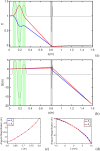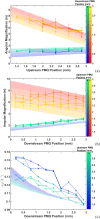High energy electron diffraction instrument with tunable camera length
- PMID: 38532924
- PMCID: PMC10965247
- DOI: 10.1063/4.0000240
High energy electron diffraction instrument with tunable camera length
Abstract
Ultrafast electron diffraction (UED) stands as a powerful technique for real-time observation of structural dynamics at the atomic level. In recent years, the use of MeV electrons from radio frequency guns has been widely adopted to take advantage of the relativistic suppression of the space charge effects that otherwise limit the temporal resolution of the technique. Nevertheless, there is not a clear choice for the optimal energy for a UED instrument. Scaling to beam energies higher than a few MeV does pose significant technical challenges, mainly related to the inherent increase in diffraction camera length associated with the smaller Bragg angles. In this study, we report a solution by using a compact post-sample magnetic optical system to magnify the diffraction pattern from a crystal Au sample illuminated by an 8.2 MeV electron beam. Our method employs, as one of the lenses of the optical system, a triplet of compact, high field gradients (>500 T/m), small-gap (3.5 mm) Halbach permanent magnet quadrupoles. Shifting the relative position of the quadrupoles, we demonstrate tuning the magnification by more than a factor of two, a 6× improvement in camera length, and reciprocal space resolution better than 0.1 Å-1 in agreement with beam transport simulations.
© 2024 Author(s).
Conflict of interest statement
The authors have no conflicts to disclose.
Figures











References
-
- Sciaini G. and Miller R. D., “ Femtosecond electron diffraction: Heralding the era of atomically resolved dynamics,” Rep. Prog. Phys. 74, 096101 (2011).10.1088/0034-4885/74/9/096101 - DOI
-
- Filippetto D., Musumeci P., Li R. K., Siwick B. J., Otto M. R., Centurion M., and Nunes J. P. F., “ Ultrafast electron diffraction: Visualizing dynamic states of matter,” Rev. Mod. Phys. 94, 045004 (2022).10.1103/RevModPhys.94.045004 - DOI

